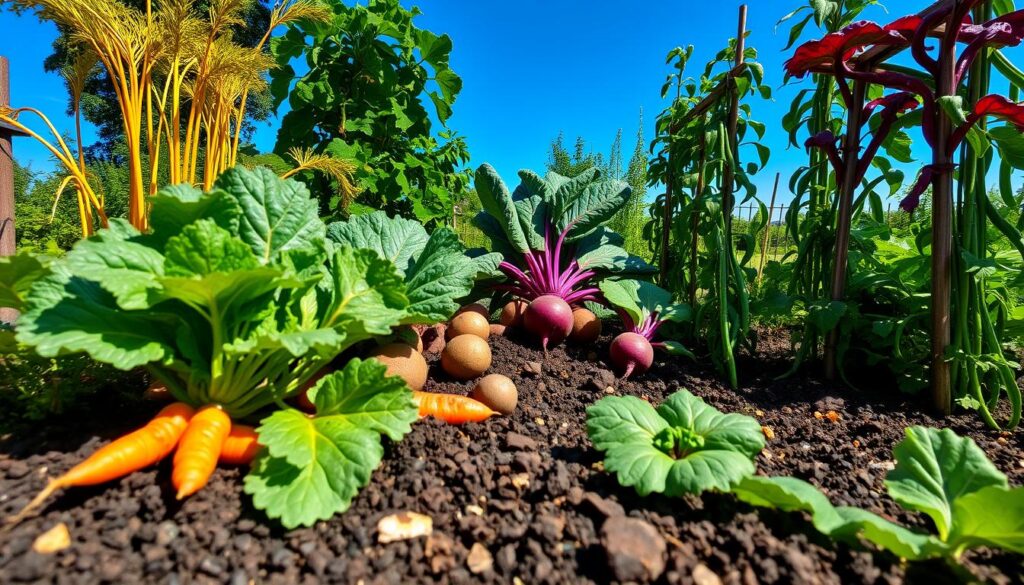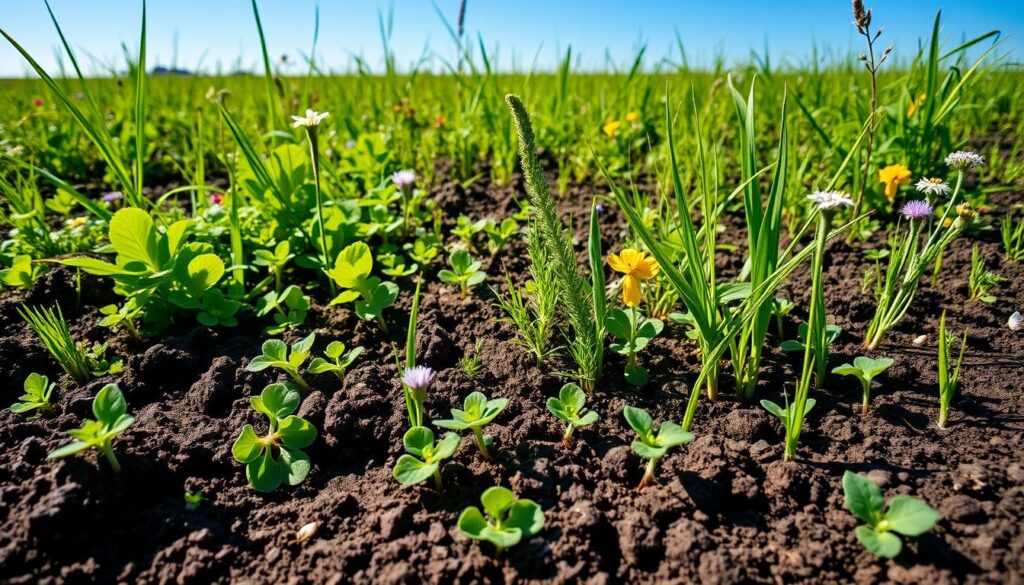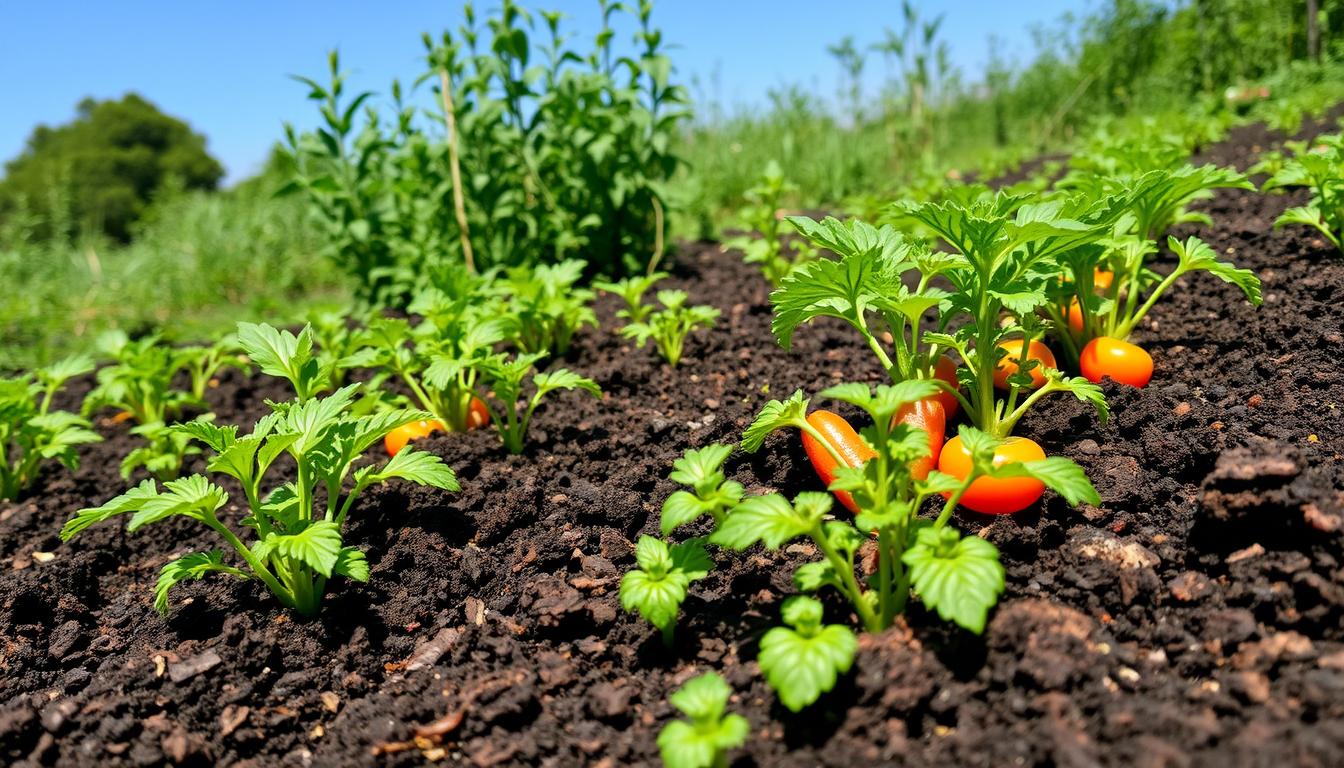I love gardening, but clay soil can be tough. It’s dense and hard to work with. But, with the right steps, you can grow great veggies in it.
This guide will share tips from my gardening years. We’ll talk about clay soil, how to make it better, and picking the right veggies. You’ll learn how to grow healthy veggies in your clay soil garden.
Key Takeaways
- Clay soil presents unique challenges for vegetable gardening, but with the right approach, you can overcome them.
- Understanding the composition and characteristics of clay soil is the first step in developing an effective gardening strategy.
- Improving soil structure through the incorporation of organic matter is crucial for enhancing drainage and nutrient availability.
- Selecting vegetables that thrive in clay soil and implementing proper planting and maintenance techniques can lead to a successful harvest.
- Addressing issues like drainage and soil pH management are essential for creating an optimal growing environment.
Understanding Clay Soil
To grow veggies in clay soil, knowing its makeup is key. Clay soil is made of fine, packed mineral particles. It’s heavy, dense, and drains slowly. Despite being very fertile, it poses unique challenges for gardeners.
Composition and Characteristics of Clay Soil
Clay soil has lots of fine, clay-like particles packed tightly. This makes it hard for air and water to move through. It also gets compacted easily, making it tough for roots to grow.
Clay soil holds onto water well, which is good in dry times but bad in wet ones. It can become waterlogged and hard, stopping water and air from getting in. This hurts many veggies’ growth.
Challenges of Clay Soil for Gardening
- Poor aeration: The dense, compact nature of clay soil can limit the flow of air and oxygen, hampering root growth and overall plant health.
- Compaction: Clay soil is prone to compaction, making it difficult for plant roots to penetrate and establish a strong foundation.
- Drainage issues: The high moisture-holding capacity of clay soil can lead to waterlogging, which can cause root rot and other problems for vegetables.
- Difficulty with water infiltration: The fine particles in clay soil can create a hard, crusty surface, impeding water absorption and gas exchange.
- Nutrient imbalances: The chemical composition of clay soil can lead to nutrient imbalances, requiring careful amendments to ensure optimal growth for vegetable crops.
Knowing clay soil’s makeup and challenges is vital for growing veggies. By tackling these issues, gardeners can make clay soil work for their gardens.
Improving Soil Structure
To tackle clay soil challenges, improving its structure is key. Adding organic matter is a top way to do this. Compost, for example, breaks down clay, improves air, and holds more water. These changes are vital for growing strong veggies.
Incorporating Organic Matter
Introducing organic matter to clay soil can transform it. Here’s how to enrich your clay soil with organic matter:
- First, test your clay soil to see how much organic matter it needs.
- Choose high-quality compost or manure. Look for something nutrient-rich and crumbly.
- Spread the organic matter over your garden bed, aiming for 2-4 inches.
- Use a fork to mix it into the top 6-8 inches of clay soil. Don’t overdo it to avoid harming the soil.
- Water well to help the organic matter blend with the clay.
By adding organic matter to your clay soil regularly, you’ll make it more fertile and drain better. This simple action is a powerful way to improve clay soil structure and boost your harvest.
“Healthy soil is the foundation for healthy plants, and incorporating organic matter is the key to improving clay soil structure.”
How to Grow Vegetables in Clay Soil: Tips and Tricks
Gardening in clay soil can be tough, but you can still grow a lot of vegetables. Whether you’re new to gardening or have been doing it for years, these tips will help. They’ll guide you through the challenges of growing veggies in clay soil.
Select the Right Vegetables
Not all veggies do well in clay soil. Pick ones that are known to grow well, like:
- Tomatoes
- Zucchini
- Carrots
- Radishes
- Beans
These veggies can handle clay soil’s dense and moist nature. They’ll help you get a great harvest.
Amend the Soil
Improving clay soil is key for growing veggies. Add organic stuff like compost or well-rotted manure. This helps with drainage and air for your plants’ roots.
Utilize Raised Garden Beds
Building raised beds is a smart move for clay soil. They let water drain better and offer a better soil mix for your veggies.
Implement Proper Watering Techniques
Watering is very important in clay soil. Don’t overwater, as it can make the soil too wet. Instead, water deeply but not too often. Mulching helps keep the soil moist too.
By using these tips, you’ll grow a great vegetable garden in clay soil. With the right steps, you can beat the challenges and enjoy lots of fresh, homegrown food.
Raised Garden Beds
Using raised garden beds is a great way to grow veggies in clay soil. These beds make growing easier by improving soil conditions. They are a top pick for gardeners.
The Advantages of Raised Beds in Clay Soil
Raised beds help a lot with clay soil. They make it easier for water to drain, keeping the soil from getting too wet. This also helps plants breathe better.
Also, you can add special soil mix to the beds. This mix has nutrients that clay soil often misses. It makes the soil better for your veggies to grow.
Constructing Raised Beds for Clay Soil
Building raised garden beds is easy. First, pick a spot that gets lots of sun and is easy to get to. Then, decide how big you want your beds to be. They should be 4 to 8 feet wide and 6 to 12 feet long, with a height of 6 to 12 inches.
- Use a hose or string to mark out the bed’s shape.
- Dig out the soil inside the marked area to make it level.
- Build the bed frame with materials like untreated wood, stone, or composite lumber.
- Fill the bed with a mix that drains well, adding compost or organic matter for better soil.
- Smooth out the top and you’re ready to plant!
Adding raised garden beds to your clay soil garden can make it a lush oasis. It lets your plants grow well. Try raised beds and see your garden grow.
Drainage Solutions
Drainage is key for a successful vegetable garden in clay soil. These soils hold water, which can harm your plants. I’ll share ways to improve drainage and boost your garden’s productivity.
Enhancing Drainage with French Drains
French drains are a top choice for better drainage. They have a pipe surrounded by gravel to move water away. Placing them right can stop waterlogging and help your garden thrive.
Incorporating Gravel and Sand
Gravel or sand in clay soil helps with drainage and air. They create spaces for water to soak in, reducing waterlogging. This simple step can greatly improve your garden’s health.
Raised Garden Beds: A Drainage Solution
Raised beds are great for clay soil. They improve air and water flow, preventing waterlogging. Adding organic matter and other techniques can make your garden perfect for growing vegetables.
With these drainage solutions, your clay soil garden can flourish. Remember, fixing drainage is vital for your garden’s success.
Choosing the Right Vegetables
Choosing the right vegetables for your clay soil garden is key to a great harvest. Not all veggies do well in clay’s dense, moist soil. Knowing what each variety needs helps you pick the best for your garden.
Vegetables That Thrive in Clay Soil
Some vegetables really shine in clay soil. Here are the top picks:
- Tomatoes: These versatile crops can adapt well to clay soil, provided you amend the soil with organic matter to improve drainage.
- Carrots: While clay soil can be challenging for carrots, certain varieties like Danvers or Nantes can perform exceptionally well with proper soil preparation.
- Beets: Beets are a great choice for clay soil gardens, as they thrive in the nutrient-rich conditions and can tolerate the moisture-retentive nature of the soil.
- Leafy Greens: Crops like kale, spinach, and Swiss chard tend to do well in clay soil, as they can adapt to the higher moisture levels.
- Onions: Onions are a hardy choice for clay soil, as they can tolerate the dense, heavy nature of the soil and still produce a bountiful harvest.
By picking these veggies, you can have a successful and rewarding growing season, even in tough garden conditions.

“The key to growing a thriving vegetable garden in clay soil is to focus on selecting the right varieties that are adapted to these unique growing conditions.”
Planting and Maintenance
Growing vegetables in clay soil needs the right planting and care. To make your garden flourish, let’s look at the important steps for planting vegetables in clay soil and maintaining your vegetable garden in clay soil.
Proper Watering Techniques
Clay soil can hold too much water, harming your plants. To fix this, use watering techniques for clay soil that help water drain and stay. Don’t overwater. Instead, water deeply but not too often to help roots grow deep and keep the soil dry.
Mulching for Moisture Retention
Adding mulch around your plants is a great way to enhance moisture retention in clay soil. Organic mulches like wood chips, straw, or leaves keep moisture in, stop weeds, and improve soil. Mulching for clay soil helps prevent water loss and ensures your plants get the moisture they need.
By following these tips for planting and maintenance in clay soil, you’ll grow a successful and fruitful vegetable garden. Even in clay soil, your garden can thrive.
Amending Soil with Compost
Growing vegetables in clay soil gets a big boost from compost. This natural, nutrient-rich material makes your clay garden beds better. It improves the soil’s structure and fertility.
Adding compost to clay soil has many benefits. It loosens the dense clay, making the soil more airy and draining well. This is key for your plants to grow healthy and strong.
Compost also adds vital nutrients to the soil. It feeds your plants and helps them grow well. The compost’s organic matter keeps the soil moist, preventing it from getting too wet or dry.
How to Incorporate Compost into Clay Soil
To get the most from compost in clay soil, mix it in right. Here’s how:
- Figure out how much compost you need. Mix in 2-4 inches of compost into the top 6-8 inches of soil.
- Spread the compost evenly over your garden bed.
- Use a garden fork or tiller to mix the compost into the soil gently. Be careful not to compact it more.
- Water the soil well to help the compost blend in and create a healthy soil structure.
By amending clay soil with compost regularly, you make a rich soil for your plants. The benefits of adding compost to clay soil are many. It’s a must for any gardener wanting to use compost to improve clay soil.
| Benefits of Amending Clay Soil with Compost | Impact on Soil |
|---|---|
| Improves soil structure | Loosens dense clay particles, increases aeration |
| Enhances nutrient content | Provides essential nutrients for plant growth |
| Increases moisture retention | Helps prevent waterlogging and drying out |
“The key to success in gardening is to create a healthy, vibrant soil foundation. Amending clay soil with compost is one of the best ways to achieve this.”
Crop Rotation and Cover Crops
Improving your clay soil garden is easier with crop rotation and cover crops. These methods tackle clay soil’s issues like poor drainage and nutrient loss. They also help with soil compaction.
Crop rotation stops pests and diseases from building up. It also makes the soil more fertile. By changing what you plant, you keep your garden healthy and productive. This also boosts the soil’s microbial life, making nutrients more available.
- Rotate crops by family, like switching between Solanaceae (tomatoes, peppers) and Brassicaceae (broccoli, kale).
- Don’t plant the same crop in the same spot every year to avoid pests and diseases.
Cover crops are great for clay soil too. They break up soil, add organic matter, and stop erosion. They also act as “green manure,” giving nutrients to your vegetables when they break down.
- Pick cover crops that fit your climate and soil, like Lupines or rye grass.
- Plant cover crops in fall, letting them grow over winter. Then, add them to the soil in spring.
- Make sure cover crops don’t become weeds and are removed before planting vegetables.
Using crop rotation and cover crops can turn your clay soil into a lush garden. It overcomes soil challenges and brings a healthier, more abundant harvest.

“Crop rotation and cover crops are essential tools for improving clay soil and creating a sustainable, productive vegetable garden.”
Soil Testing and pH Management
Keeping the soil pH right is key for a healthy vegetable garden in clay soil. Clay soils tend to be more alkaline, which can block nutrients for plants. Regular soil tests help you manage your garden’s pH levels.
Adjusting Soil pH for Optimal Growth
Soil tests show you your clay soil’s pH and guide you to adjust it. Most veggies grow best in a pH between 6.0 and 7.0. If your test shows a different pH, you can adjust it to suit your veggies.
- If the soil is too acidic (low pH), you can add lime to raise the pH.
- If the soil is too alkaline (high pH), you can incorporate sulfur or other acidifying agents to lower the pH.
Always follow your soil test’s advice and adjust pH slowly. Sudden changes can harm your plants. By managing pH, you help your veggies get the nutrients they need, even in tough clay soil.
| Soil pH Range | Nutrient Availability |
|---|---|
| 5.5 or lower | Excess of iron, aluminum, and manganese. Deficiency of phosphorus, calcium, magnesium, and molybdenum. |
| 6.0 to 7.0 | Optimal nutrient availability for most vegetables. |
| 7.5 or higher | Deficiency of iron, manganese, boron, copper, and zinc. |
“Proper soil testing and pH management are essential for growing a thriving vegetable garden in clay soil. By understanding and adjusting the soil pH, you can unlock the full potential of your garden and ensure your plants receive the nutrients they need to flourish.”
Conclusion
As we wrap up our exploration of growing veggies in clay soil, I’m sure you now have the tools to create a lush garden. You’ve learned about clay soil’s special traits, how to improve it, and which veggies grow best. This knowledge will help you beat the challenges clay soil presents.
To garden well in clay soil, add organic matter, build raised beds, and ensure good drainage. Keep the soil moist with smart watering and mulching. Also, rotate crops and use cover crops to keep the soil healthy and fertile. Regularly check and adjust the soil pH to make it perfect for your plants.
Starting your clay soil garden? Be patient, flexible, and keep trying. With the right strategy and some trial and error, you’ll enjoy a lively and fruitful garden. Embrace clay soil’s challenges and show off your gardening skills. Your garden will flourish, giving you plenty of fresh produce for years.



Leave a Reply